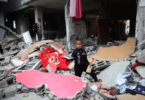An explosion near the Abu Muslim Khorasani Mosque in Kabul was reported on Thursday, which presumably had been detonated by the Islamic State Khorasan (IS-K). Previously, Daesh claimed an explosion that occurred in the eastern part of the Afghan capital resulting in 3 deaths and 4 injuries. This marks the second attack in a week in the city of Kabul for which ISIS has claimed responsibility. Yesterday’s attack seems to be the part of the ongoing series of attacks being launched by the banned terror outfit in Afghanistan.
The Taliban government is nearly to complete two and a half years of its sovereign control of the country since taking power in mid August 2021. Over the past years, the major challenges encountoured by the interim rulers other then their self created issues relating to human and women rights and softcorner for terror outfits had been the acute economic and humanitarain crisis together with the serious secuirty risks enminating from the Islamic State commonly known as IS-K, the branch of the infamous Daesh operating in the AfPak region. A low level insurgency by the anti- Taliban elements in the previous Republican setup and the ruins of the Northern Allaince are gradually simmering in Northern parts of the country. While a strong political allaince comprising of Salahiddun Rabbani’s Jaimat-e-Islami party, Ahmed Wali Massoud group and anti-Taliban politicians is currently mulling over the scenarios to collectively launch efforts to depose Taliban from Kabul.
The Islamic State Khorasan Province (ISKP), the Afghan chapter of Daesh has expanded its network and gradually shaped into a grave security risk for interim Taliban government in Afghanistan. Historically, the global Intelligentsia and regional experts already warned about the potential upsurge in terrorism immediatly after Taliban took over of the country because of their ideological conflict with the ruling cleric regime and massive attraction among the youths from a particular faction of the Muslim society in the greater AfPak region. Since the Taliban took control of the country, the Taliban forces remained engaged against their adversaries, while their main challenge was to forestall incidents like explosions, targeted killings, and acts of terror which continuously occurring in various parts of the country. The recent series of explosions in the Afghan capital had caused great worries in Taliban authorities who often under estimated the threat poses by Daesh.
In fact, the Islamic State’s presence in Afghanistan is not a risk only meant for Afghanistan but it is a real threat to all adjoining nations in the broader Indo-Subcontinent including Pakistan, India, Bangladesh, Maddives, Sri Lanka and Myanmar that constitute a significant Muslim population and all those peripheries are equally expose to the presence and extremist activities of the hardline militant groups due to prevailing social injustices, and bad governance in the Muslim states while rising Islamophobia and religious bigotry in non-Muslim countries in South Asia. In Afghanistan case, the Islamic State faces a struggle for relevance in the face of competition with the ruling rival militant group and strong counterterrorism pressure in the entire AfPak area.
Presently, the IS-KP poses a growing threat to Afghanistan due to the absence of a strong law Enforcement, technical expertise and Intelligence mechanism. The Afghan government lacks capacity to effectively defeat Daesh, yet lax border control and difficult mountanious terrains obstruct effective border management and facilitate cross border movement of terrorist groups that is real threat for almost all nations in South and Central Asia. There is a need for teamwork, collective efforts and counter terrorism cooperation between all neighbouring states to effectively defeat this common threat as early as possible otherwise no nation will be secure from it’s malignance in the future.







